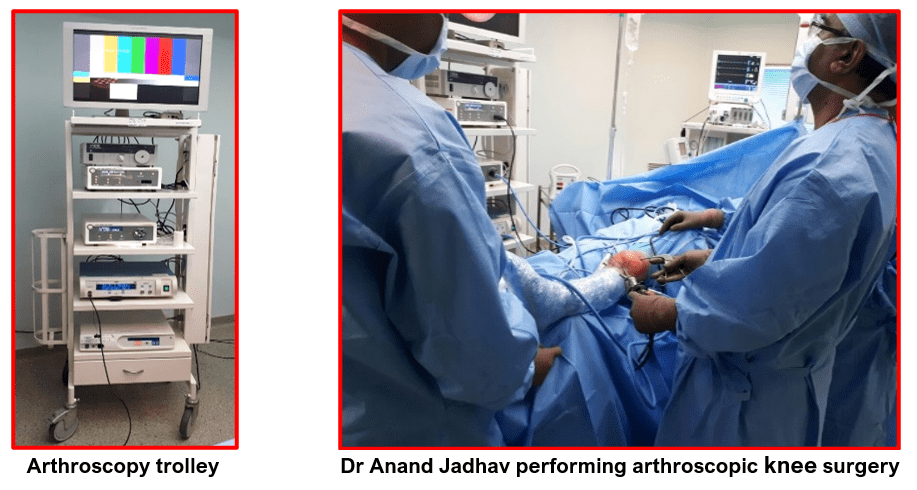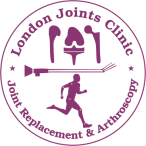Knee Arthroscopy
Knee arthroscopy is a commonly performed key-hole surgery of the knee. The surgeon first makes portals (tiny keyholes) on either side of the kneecap. He then inserts an arthroscope (small telescope) with attached video camera to look into the knee joint from one portal and special instruments, as needed, are used through the other portal. The images from the knee are seen on a large screen monitor which helps the surgeon to diagnose or treat multiple knee problems under arthroscopic vision. Images of the knee pathologies and videos of the surgery can also be recorded. Patients are given a copy of these photos and video recordings.
Knee arthroscopy is a relatively safe procedure. Majority of the patients get discharged from the hospital on the same day of surgery or the next day.
Dr Anand Jadhav has 27 years of surgical experience. He has undergone highly advanced and specialised training in arthroscopic surgeries of the knee joint across multiple centres in the UK, Europe and the USA. He prefers to do arthroscopic knee surgeries at hospitals that have all the necessary specialised equipment along with trained support staff. This helps him in providing best outcomes to the patients.
Knee arthroscopy, being a minimally invasive procedure, offers several advantages:
- Smaller scar which are cosmetically better
- Less tissue injury
- Minimal pain
- Shorter hospitalisation (day care or 1 day stay)
- Faster recovery
The knee joint is vulnerable to a variety of injuries as well as non-traumatic lesions.
The most common knee problems where knee arthroscopy may be recommended for diagnosis and treatment are:
- Meniscal tears
- Torn or damaged cruciate ligaments (ACL & PCL)
- Various lesions of articular cartilage
- Inflamed synovial tissue and its lesions
- Malalignment of patella
- Baker’s cyst: a fluid filled cyst that develops at the back of the knee due to the accumulation of synovial fluid. It commonly occurs with knee conditions such as meniscal tear, knee arthritis and rheumatoid arthritis. It is important to note that most often it is NOT necessary to operate on the cyst but merely to correct the problem causing the excess fluid.
- Certain fractures of the knee bones e.g. ACL Avulsions, Intra-articular fractures of tibia or femur
The steps involved in a knee arthroscopy are:
- Knee arthroscopy is performed in a suitably counselled patient with proper consent.
- Knee arthroscopy is done either under spinal or general anaesthesia. Our anaesthetist will decide the best method for you depending on your age and health condition.
- The surgeon will make two (occasionally 3) small 5mm incisions (portal or keyholes) around the knee on either side of the patella (kneecap).
- A sterile fluid solution is injected into the knee to distend it which pushes apart the various internal structures to provide a clear view and make more room to work.
- An arthroscope (a narrow telescope) with a tiny video camera on the end, is inserted through one of the incisions to view the knee joint. The structures inside the knee are visible on a large video monitor in the operating room.
- The surgeon first examines the structures inside the knee joint to assess the cause of the problem and take detailed photo images, which can be shown to patients after their surgery.
- Once the diagnosis is made or confirmed, surgical instruments such as scissors, motorized shavers, or radiofrequency probes (similar to lasers) are inserted through another portal, and the necessary work is performed based on the diagnosis and need.
The procedures performed arthroscopically may include any of the following:
- Removal or repair of a torn meniscus
- Reconstruction of a torn cruciate ligament (ACL or PCL)
- Removal of small torn pieces of articular cartilage and smoothing of the defect to
- promote healing
- Removal of loose fragments of bones or any other loose bodies
- Removal of inflamed synovial tissue (synovectomy), plicas or fat pad/alar folds
- Removal of Baker’s cyst (very rarely necessary)
- Realignment of the patella or simple lateral release for patellar malalignment
- Making small holes (Microfractures) in the damaged articular cartilage to stimulate cartilage regrowth
- After completion of the arthroscopy, the knee joint is carefully examined for bleeding or any other damage.
- Thenjoint is washed outwith the irrigation saline to clear any debris. The saline fluid is then drained from the knee joint as much as possible. If bleeding is likely to occur in the knee, a suction drain will be inserted and removed after 24 hours.
- Finally, the incisions are closed with sutures or sterile sticky tapesand covered with sterile dressing pads. Compression bandages are given. Patient is then shifted to the recovery room for observation.
- Most patients are discharged the same day or the next day after knee arthroscopy. Recovery after the surgery depends on the type of procedure performed. Recovery from simple procedures is often fast. However, recovery from complicated or complex procedures takes a little longer. Patients are counselled pre-operatively about their recovery time which can be between 2 to 6 weeks for simple procedures and 6 to 12 weeks for complex procedures.
- Recovery from knee arthroscopy is much faster than that from an open knee surgery.
- Pain medicines are prescribed to manage pain for the first 3 to 5 days. Thereafter they are taken only if required.
- Ice packs are given 4 to 5 times a day and carried on for 1 to 2 weeks.
- Physiotherapist visits patients prior to their discharge. Knee exercises are taught and then carried on by patient at home for 2 to 4 weeks. For complex surgeries patients may need to be seen by a physiotherapist on a regular basis and for longer duration of about 2 to 3 months. This type of formal rehabilitation program ensures successful and faster recovery.
- Crutches are not always required. But they may be needed for complex surgeries. For simpler surgeries patients can start full weight bearing immediately after surgery. Some surgeries may need non-weight bearing or partial weight bearing for tissue protection and to allow healing.
Knee arthroscopy is a safe procedure and complications are very rare. Complications that may arise from knee arthroscopic surgery are bleeding into the knee joint, infection, swelling, knee stiffness, blood clots, damage to surrounding nerves, blood vessels, joint cartilage, meniscus, ligaments and continuing knee problems.
Book An Appointment
Private Clinics : Locations & Directions
London Joints Clinic (Pune)
Address
Office S 5, 2nd Floor, North Block, Sacred World Mall,
Opp Sacred Heart Township, Near Jagtap Chowk,
Wanawadi, Pune 411040
Monday to Saturday
6 PM to 9 PM
Appointments
Hospitals OPDs : Locations & Directions
Jupiter Hospital (Baner)

Address
Lane 3, Baner- Balewadi Road,
Prathamesh Park,
Baner, Pune 411 045
Monday to Saturday 11 AM to 4 PM
Appointments
Contact us
Dr Anand Jadhav has a centralised appointment system for all locations across various hospitals and clinics in Pune & PCMC areas
Appointment Bookings & Requests can be made by any method :

